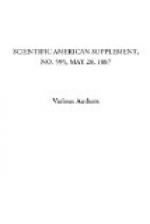It would be difficult to discover not only how a locust can expend sufficient energy to impart to molecules of the air, so as to set them in a forced vibration, and thus enable a pulse of the energy imparted to control the motion of the supposed molecules of the air for a mile in all directions, but also to estimate the amount of energy the locust must expend.
According to the wave theory, a condensation and rarefaction are necessary to constitute a sound wave. Surely, if a condensation is not produced, there can be no sound wave! We have then no need to consider anything but the condensation or compression of the supposed air molecules, which will shorten the discussion. The property of mobility of the air and fluidity of water are well known. In the case of water, which is almost incompressible, this property is well marked, and unquestionably would be very nearly the same if water were wholly incompressible. In the case of the air, it is conceded by Tyndall, Thomson, Daniell, Helmholtz, and others that any compression or condensation of the air must be well marked or defined to secure the transmission of a sound pulse. The reason for this is on account of this very property of mobility. Tyndall says: “The prong of the fork in its swift advancement condenses the air.” Thomson says: “If I move my hand vehemently through the air, I produce a condensation.” Helmholtz says: “The pendulum swings from right to left with a uniform motion. Near to either end of its path it moves slowly, and in the middle fast. Among sonorous bodies which move in the same way, only very much faster, we may mention tuning forks.” Tyndall says again: “When a common pendulum oscillates, it tends to form a condensation in front and a rarefaction behind. But it is only a tendency; the motion is so slow, and the air so elastic, that it moves away in front before it is sensibly condensed, and fills the space behind before it can become sensibly dilated. Hence waves or pulses are not generated by the pendulum.” And finally, Daniell says: “A vibrating body, before it can act as a sounding body, must produce alternate compressions and rarefactions in the air, and these must be well marked. If, however, the vibrating body be so small that at each oscillation the surrounding air has time to flow round it, there is at every oscillation a local rearrangement—a local flow and reflow of the air; but the air at a distance is almost wholly unaffected by this.”
Now, as Prof. Carter has shown by experiment that a tuning fork while still sounding had only an amplitude of swing of 1/17000 of an inch, and only traveled an aggregate distance of 1/33 of an inch in one second, or one inch in 33 seconds, surely such a motion is neither “swift,” “fast,” nor “vehement,” and is unquestionably much “slower” than the motion of a pendulum. We have only to consider one forward motion of the prong, and if that motion cannot condense the air,




